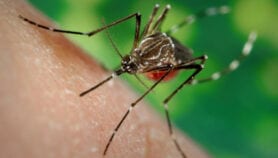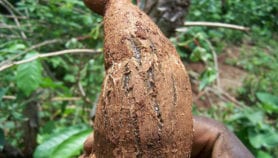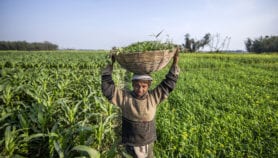By: David Dickson
Send to a friend
The details you provide on this page will not be used to send unsolicited email, and will not be sold to a 3rd party. See privacy policy.
The world’s largest study of the potential impact of genetically modified crops on the environment has produced an ambiguous set of results result. Ironically, this conclusion should make future decisions easier.
Any politician who had hoped that science would be able to tell them whether genetically modified (GM) crops are safe to plant will have been left frustrated by the results of extensive farm trials released in London last week (see GM crop trials provide mixed message). The trials were carried out on 60 British farms over the past three years to assess GM herbicide resistant varieties of three crops: oil-seed rape (widely grown as a source of cooking oil), beet, and maize. In each case, and on each farm, a direct comparison was made between the impact of using the GM variety on weeds and insects, and that of using a conventional variety of the crop.
The results of the tests were mixed. Two of three crops — oil-seed rape and beet — came out badly. In both cases, the farming practices adopted for the GM variety resulted in a decrease in the number of insects, which in turn is likely to have reduced the level of birds and other wildlife which depend on them for food. In the case of maize, however, the result was the opposite; growing the GM variety resulted in an increase in insect life, likely to have a beneficial impact on the natural environment.
Environmentalists — and most of the media — were quick to pick up the negative message from the experiments, namely that previous assertions by scientific advisory boards and others about GM crops having no adverse environmental impacts were wrong. For many in Britain in particular, the results of the trials of oil-seed rape and beet represented the final nail in the coffin for GM crops, already under fire on a wide range of fronts. A report several weeks previously, for example, had argued that such crops were likely to have minimal economic advantages for UK farmers.
But, in a global context, a more nuanced interpretation is essential. For the main message of the farm trials was not clear-cut; the fact that some of the crops had a negative impact, while in other cases the impact was benign, confirmed the need to assess such crops on a case-by-case basis, and to avoid any type of blanket judgement. Furthermore, the experimental and analytical techniques employed in the studies demonstrated that even if science cannot answer the question of whether GM crops in general are safe, it can provide a way of measuring environmental impacts that are directly relevant to this question in specific instances.
Implications for developing countries
Both conclusions have immediate and important messages for those keen to see GM crops grown in developing countries. The first is essentially positive; the ambiguous results of the British trials indicate that it would be wrong to cite environmental impacts on wildlife as a reason for imposing a ban on all such crops. However, the study did not address other issues which generate different concerns, in particular the spread of “engineered” genetic traits into native varieties of staple crops. In contrast, the trials show that there are circumstances in which the use of GM crops can actually benefit wildlife.
This is no reason for abandoning caution; if anything, the trials underlined the importance of close analysis of the potential impact of individual crops and the farming methods used to produce them. And this, of course, is likely to place an additional responsibility on governments keen to see their farmers grow such crops, but in a manner that does not harm the environment.
In particular, it is likely to mean firstly that each proposed crop must be assessed individually, itself a not insignificant task (the UK farm scale trials, which only covered three crops, involved taking more than hundreds of thousands of soil and insect samples over the three-year period). Secondly, the trials underline the need to consider the concept of “environmental impact” in the broadest possible context, namely not only the immediate physical impact, but also the disruption to ecological cycles caused by changes in farming practices.
Both of these have significant resource implications. They will also require ensuring that adequate training is provided if researchers are able to carry out such tests in a reliable fashion. Indeed, one of the strongest arguments against the widespread adoption of GM in developing countries is that the lack of adequate monitoring and enforcement could put populations and the environment at much higher risk than in countries with tough enforcement. Look at the air pollution crisis facing many cities in the developing world; or, the apparent ease with which Brazilian farmers have been able to smuggle illegal GM seeds into the country from neighbouring Argentina.
Continuing uncertainties
Another simplistic conclusion to be avoided about the results of the UK farm trials is that GM maize is safe to plant — or at least safer than the other crops in the study. As commentators on the results have been quick to point out, the apparent harmlessness of the GM variety of maize is primarily accounted for by the relative toxicity of the herbicide atrazine used on conventional maize crops. It was therefore not surprising that significantly reducing the amount of herbicide used, and therefore allowing weeds to flourish until a relatively late stage in the growing cycle, reduced harmful impacts on wildlife.
The sting in the tail here is that atrazine is about to be withdrawn as a result of European regulations. But the results of the farm-scale trials, as even the researchers themselves are quick to point out, are specific to crops that have been genetically modified for resistance to this particular herbicide. GM maize resistant to other herbicides will require a new set of tests (or at least modification of the conclusions from the current ones).
Furthermore whereas the results are significant for maize farming in temperate zones, it would be inappropriate to extrapolate them to other regions where, even if the same herbicide is used, growing conditions and farming practices may be entirely different. The benign impact of the GM maize in Britain was a direct result of the new weed control practices that it allowed farmers to adopt, rather than the biological characteristics of the new variety itself. Certainly there is little in the tests to justify the claim of one industry lobby group (CropGen) that they demonstrated that GM maize is “better for biodiversity”.
The caution suggested by the UK experiments is entirely appropriate. Chemical poisoning may produce the same symptoms worldwide. But disruption of biodiversity and ecological cycles is a more subtle process, requiring a higher level of both analysis and understanding — and thus eventually of monitoring (including monitoring of agronomic practices). In situations where this disruption can be easily reversed, the threat may not be significant. In other situations, for example when important food cycles are at stake, extra caution is clearly needed.
Ironically, while both sides in the GM debate have sought to interpret the UK trials to suit their agendas — environmentalists argue that they demonstrate once again that GM crops are dangerous, industry that they are “flexible” — the real lesson for the protagonists seems to be different. For environmentalists, the lesson must be that even though such crops can be dangerous for the environment, they can also enhance it; for industry there is an equally important lesson, namely than blanket assertions that GM crops and the new farming practices they encourage will not damage natural processes — at least no more than conventional crops — are no longer credible.
Some might argue that, by introducing yet further uncertainties into the decision-making process, science has only muddied waters that it should be clarifying. But it is equally possible to argue that scientists have just been doing what is most needed in the whole debate: putting hypotheses to the test in the real world, and producing robust conclusions that need to be taken into account by both sides. This, in itself, will not point the way forward, either to regulators or politicians. But it helps to provide a firm basis on which both can plan their future strategies.













